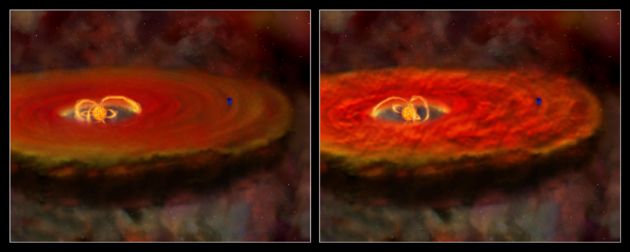Violent Young Stars Hint at Earth's Wild Start

Updated 1:30 p.m. ET
The Sun might have had an incredibly violent youth in which tremendous X-ray flares battered the Earth into being, a new star survey suggests.
In examining 30 very young Sun-like stars, astronomers found that some were relatively calm while others kicked up flares that were vastly more powerful than anything the Sun generates today.
Astronomers are not overly surprised to find stars were more active in their youth, but the results suggest a non-intuitive outcome.
While one might assume a violent beginning wouldn't favor the development of planets, just the opposite might be true, according to one theory. The reasoning goes like this: Intense flares might keep developing planets at bay, whereas without the flares a rocky world might tumble in and be vaporized by a newborn star.
Planet birth
Rocky planets like Earth are thought to form in the first few million years after a star is born. Dust orbits a newborn star in a flat disk. Some sticks to make asteroid-like objects. These often collide and are destroyed, but some come together more gently, and planets are born.
Breaking space news, the latest updates on rocket launches, skywatching events and more!
One theory holds that X-ray flares would heat a planet-forming disk and give it an electric charge. The charge combined with the disk's motion and magnetic fields would create turbulence. The turbulence would knock planets in and out, "something like boats tossed about by waves on a storm," explained astronomer Joan Najita of the National Optical Astronomy Observatory.
Overall, the effect would prevent a planet's tendency otherwise to rapidly migrate inward, Najita said in a teleconference with reporters Tuesday.
The new observations, by NASA's Chandra X-ray Observatory, found flares on some Sun-like stars are 100 times more powerful than on others. On the average star in the survey, a flare more powerful than modern solar flares occurs once a week.
About half the stars in the survey, in the Orion star-forming region about 1,500 light-years away, show evidence for harboring disks from which planets might form.
"We don't have a time machine to see how the young Sun behaved, but the next best thing is to observe Sun-like stars in Orion," said Scott Wolk of the Harvard-Smithsonian Center for Astrophysics. "We are getting a unique look at stars between one and 10 million years old -- a time when planets form."
What about us?
Theorists don't know where the Sun formed. It might have been born in isolation, collapsing from a cloud of interstellar gas and dust. Most stars form in dense regions like Orion, however.
The Sun might have formed in an Orion-like environment, only to be booted out to its present, lonely position, according to one theory. Such a chaotic beginning might explain why Uranus and Neptune are largely blocks of ice; perhaps their outer gaseous envelopes were stripped by radiation from stars that were once nearby, the thinking goes.
"Big X-ray flares could lead to planetary systems like ours where Earth is a safe distance from the Sun," said Eric Feigelson of Penn State University, and principal investigator for the international Chandra Orion Ultradeep Project. "Stars with smaller flares, on the other hand, might end up with Earth-like planets plummeting into the star."
The astronomers pointed out that while solar flares today are seen as threatening to satellites and even cause radiation concerns for people in aircraft, the more powerful flares that might have occurred early in our Sun's history helped create a world where life would later form.
The scope of the early chaos is staggering: hundreds of millions of powerful flares would on a young star during the time it takes for an Earth-like planet to form.
No Earth-sized planets have been found around other stars, but technology hasn't matured enough to detect anything so small. Astronomers expect to find several rocky planets later this decade with new space-based telescopes.
An artist's animation of a typical flare can be seen here.
- 10 Years of Planet Hunting: Amazing Variety Out There
- Eccentric Worlds: Strange Orbits Puzzle Astronomers
- Two Neptune-Mass Planets Found, Earth-Size Worlds Next
- Solar System Makeover: Wild New Theory for Building Planets
- Amid the Universe's Chaos, a Few Habitable Places

Rob has been producing internet content since the mid-1990s. He was a writer, editor and Director of Site Operations at Space.com starting in 1999. He served as Managing Editor of LiveScience since its launch in 2004. He then oversaw news operations for the Space.com's then-parent company TechMediaNetwork's growing suite of technology, science and business news sites. Prior to joining the company, Rob was an editor at The Star-Ledger in New Jersey. He has a journalism degree from Humboldt State University in California, is an author and also writes for Medium.
